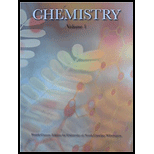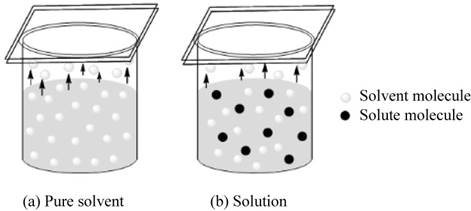
Interpretation: The experimental procedure to test the hypothesis that solute blocking of solvent vaporization is not the reason that solutions have lower vapor pressures than the pure solvents is to be determined.
Concept introduction: According to Raoult’s law, the vapor pressure of a solution is equal to the product of the mole fraction and the vapor pressure of the pure solvent.
The expression of Raoult’s law is,
Answer to Problem 1DE
Solution: The interaction between solute and solvent and the number of solute particles are responsible for the lower vapor pressures of the solution than the pure solvents.
Explanation of Solution
According to Raoult’s law, the vapor pressure of a solution is equal to the product of the mole fraction and the vapor pressure of the pure solvent.
The expression of Raoult’s law is,
When a solute is added to a solution, the vapor pressure of the solution decreases because on addition of solute, the gap between the solvent molecules gets filled. Hence, on the surface of solution, the number of solvent molecule is less as compared to the pure solvent. This indicates that the number of solvent molecule enter into the gas phase is less and due to this there is a decrease in vapor pressure.
Using the Raoult’s law, the lowering of vapor pressure can be explained.
Assume two sealed containers, one is for pure solvent and other is for solution. The equilibrium stage arises when the number of molecules striking on the surface of the molecule becomes equal to the number of molecules going to the gas phase. On addition of solute, half of the surface of the solution is occupied by the solute and half of the surface is occupied by solvent molecules.

Figure 1
The vapor pressure of the solution depends upon the number of solvent molecule present on the surface of the solution. As the number of solute molecule increases, the number of solvent molecule present on the surface of solution decreases, now lesser number of solvent molecules is present to go in gas phase. Hence, the vapor pressure of the solution decreases.
The attraction between molecules of solvent with solute also plays an important role in lowering the vapor pressure. If there is a strong attraction between the solute and solvent, than the solvent molecule try to remain in the solution rather than escaping from it. Due to this, lowering of vapor pressure occurs because now there are less number of solvent molecule in vapor phase.
Another important factor is that, number of molecules present in the solution is not important rather than this number of solute particles present in the solution is important.
More the number of solute particles, low will be the vapor pressure.
The interaction between solute and solvent and the number of solute particles are responsible for the lower vapor pressures of the solution than the pure solvents.
Want to see more full solutions like this?
Chapter 13 Solutions
CHM 101 VOL 1 2014 >IC<
 ChemistryChemistryISBN:9781305957404Author:Steven S. Zumdahl, Susan A. Zumdahl, Donald J. DeCostePublisher:Cengage Learning
ChemistryChemistryISBN:9781305957404Author:Steven S. Zumdahl, Susan A. Zumdahl, Donald J. DeCostePublisher:Cengage Learning ChemistryChemistryISBN:9781259911156Author:Raymond Chang Dr., Jason Overby ProfessorPublisher:McGraw-Hill Education
ChemistryChemistryISBN:9781259911156Author:Raymond Chang Dr., Jason Overby ProfessorPublisher:McGraw-Hill Education Principles of Instrumental AnalysisChemistryISBN:9781305577213Author:Douglas A. Skoog, F. James Holler, Stanley R. CrouchPublisher:Cengage Learning
Principles of Instrumental AnalysisChemistryISBN:9781305577213Author:Douglas A. Skoog, F. James Holler, Stanley R. CrouchPublisher:Cengage Learning Organic ChemistryChemistryISBN:9780078021558Author:Janice Gorzynski Smith Dr.Publisher:McGraw-Hill Education
Organic ChemistryChemistryISBN:9780078021558Author:Janice Gorzynski Smith Dr.Publisher:McGraw-Hill Education Chemistry: Principles and ReactionsChemistryISBN:9781305079373Author:William L. Masterton, Cecile N. HurleyPublisher:Cengage Learning
Chemistry: Principles and ReactionsChemistryISBN:9781305079373Author:William L. Masterton, Cecile N. HurleyPublisher:Cengage Learning Elementary Principles of Chemical Processes, Bind...ChemistryISBN:9781118431221Author:Richard M. Felder, Ronald W. Rousseau, Lisa G. BullardPublisher:WILEY
Elementary Principles of Chemical Processes, Bind...ChemistryISBN:9781118431221Author:Richard M. Felder, Ronald W. Rousseau, Lisa G. BullardPublisher:WILEY





